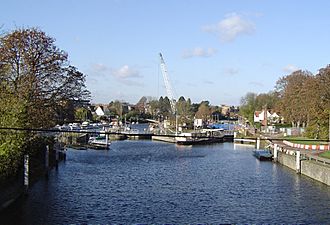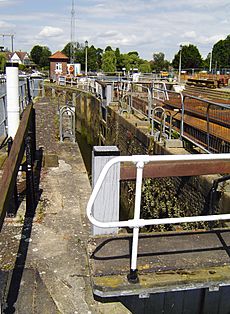Teddington Lock facts for kids

Teddington Lock undergoing maintenance. From left to right – rollers, skiff lock, launch lock and barge lock
|
|
| Waterway | River Thames |
|---|---|
| Country | England |
| County | Greater London |
| Maintained by | Environment Agency |
| Operation |
|
| First built |
|
| Length |
|
| Width |
|
| Fall | 2.68 m (8 ft 10 in) |
| Above sea level | 14 ft (4.3 m) |
| Coordinates | 51°25′54″N 0°19′26″W / 51.43167°N 0.32389°W |
| Teddington is normally manned 24 hours | |
Teddington Lock is a special place on the River Thames in London, England. It is made up of three different locks and a weir. A lock is like a water elevator for boats, and a weir is a barrier that controls water flow.
This important site is located between the areas of Ham and Teddington. It was first built way back in 1810. Teddington Lock also marks the point where the river changes from being affected by the ocean's tide to being a non-tidal river further upstream. It is the lowest lock on the Thames that is always affected by the tide.
The whole area includes a very long weir and three locks:
- A regular lock for boats like launches.
- A very large lock for big barges and passenger boats.
- A small lock for skiffs (small, light boats).
The big barge lock has extra gates in the middle. This helps it work faster for smaller boats. There are also two narrow islands that are part of the lock system. You can walk across the upper island using the footbridge.
Contents
Exploring Teddington Lock
The largest lock is on the south side of the river, near the towpath. This path is a walking route along the river. The most used lock is in the middle, on a long, thin island. This island has grassy areas, places for boat owners to relax, and a cabin for the lock keeper. There is also a special concrete ramp for canoes and kayaks.
Downstream from the lock, the river is called the Richmond and Twickenham reach. This part of the river is partly tidal. This means the water level changes with the ocean's tide, but not as much as in the sea. This is because of the Richmond Lock, which helps keep the water level steady for boats.
Even though the weir at Teddington usually marks the end of the tidal river, sometimes after a lot of rain, the tide can push the water even further upstream. This can cause swirling water, called eddies, as far as the next lock upstream.
The big, curved Teddington Weir is on the opposite side of the river. Two footbridges cross over the locks, the middle island, and the weir. These bridges are at different heights and connect the two sides of the river.
History of the Lock
Building the First Lock in 1810
In the early 1800s, people wanted to build locks on the River Thames to make it easier for boats to travel. After many plans, an Act of Parliament was passed in 1810. This law allowed locks and weirs to be built at several places, including Teddington.
Work on Teddington Lock began in September 1810. There were some delays because of floods, but the lock was finished and opened in June 1811. The weir was completed later. This first lock was located a bit further upstream than the locks you see today. It had three sets of gates.
At first, local fishermen and boatmen did not like the new lock. They even tried to damage it! Because of this, the lock keeper was allowed to keep a special gun to protect the lock from attacks.
Rebuilding and Changes in 1857
By 1827, the original wooden lock needed a lot of repairs. In 1829, the weir was even destroyed by a lot of ice. In 1843, the lock keeper stopped a steam boat from going through the lock. Back then, steam boats were not allowed to travel past Richmond.
The lock was rebuilt starting in 1854. The new lock, which is the central one today, opened in 1858. A narrow lock for skiffs was also built at this time. A special slide for boats was added in 1869. In the 1870s, the weir broke twice, causing a lot of damage. After it was rebuilt in 1871, it had many sluice gates to control the water.
Footbridges and the Big Barge Lock
The footbridges that cross the lock were opened in 1889. These bridges are now protected as historic buildings. Finally, the biggest lock on the river, the barge lock, was built between 1904 and 1905. A lot of gravel dug out during its construction was used to raise the level of a nearby island, Cross Deep Ait, to protect it from floods.
Teddington Lock in World War II
In 1940, during World War II, Teddington Lock became a very important meeting point. Many small boats from all over the River Thames gathered here. These boats were then used in the famous evacuation of Dunkirk, where they helped rescue soldiers.
Activities and Clubs on the River
There are special markers on the river between Kingston Bridge and Raven's Ait. These markers help boat users check their speed. Powered boats are not allowed to go between these markers in less than one minute, except in emergencies.
The river here is a popular spot for many water sports! It is home to:
- At least five sailing clubs.
- Five rowing clubs.
- Two skiffing and punting clubs.
- The Royal Canoe Club.
- Two Sea Cadet centres.
Many pleasure boats also operate here, offering trips between Kingston and Hampton Court.
Walking the Thames Path
The Thames Path is a long-distance walking trail that follows the River Thames. At Teddington Lock, the path follows the Surrey side of the river. It continues to Kingston Bridge, where it crosses over to the other side, running alongside Hampton Court Park. It then returns to the "Surrey side" at Hampton Court Bridge.
Sports Clubs on the Reach
- Royal Canoe Club
- Kingston Rowing Club

- Walbrook Rowing Club

- Tiffin School Boat Club

- Kingston Grammar School Boat Club

- Kingston University Boat Club

- The Skiff Club

- Dittons Skiff and Punting Club
- Thames Sailing Club
- Tamesis Sailing Club
- Minima Yacht Club
- Kingston Royals Dragon Boat Racing Club
- 1st Surbiton (Sealion) Sea Scouts
- Ajax Sea Scouts
- Leander Sea Scouts




